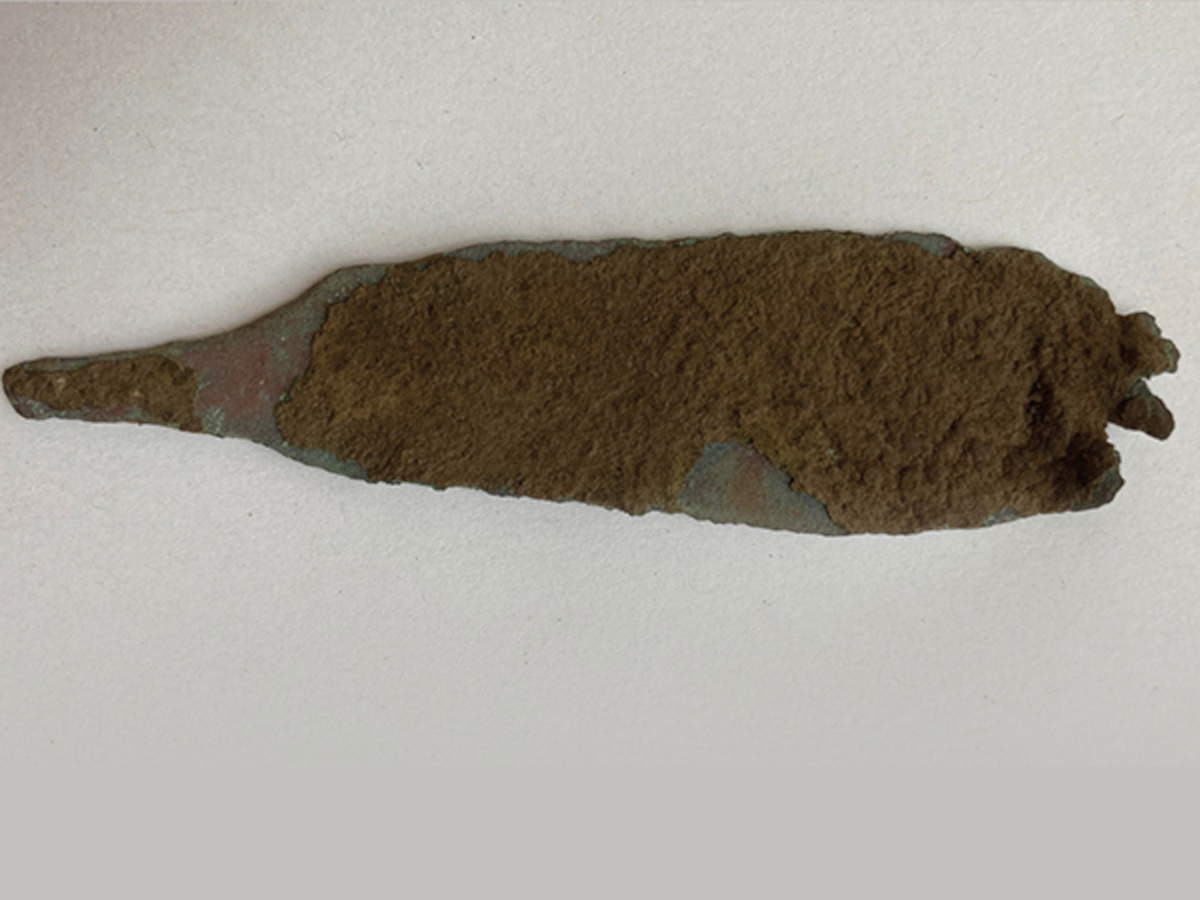Rare 4,000-year-old copper dagger found in Trieste Karst
A rare dagger dating back more than 4,000 years to theCopper Age has been found in Tina Jama Cave, located in the Trieste Karst in Sgonico. The discovery, which occurred along with numerous ceramic fragments and stone artifacts, is the result of excavation activities conducted by researchers fromCa’ Foscari University of Venice.
The discovery was presented on Wednesday, October 23, in Trieste at Palazzo Economo, headquarters of the Soprintendenza Archeologia, Belle Arti e Paesaggio for Friuli Venezia Giulia. The event was attended by Monica Hrovatin, mayor of Sgonico; Andrea Pessina, regional secretary of the Ministry of Culture for Friuli Venezia Giulia; Roberto Micheli, an official of the Superintendency; Federico Bernardini, professor of Archaeological Research Methodology at Ca’ Foscari University; and Elena Leghissa of the Institute of Archaeology of the Research Center of the Slovenian Academy of Sciences and Arts.
The excavation work was conducted by Ca’ Foscari University of Venice, under a concession from the Ministry of Culture, in collaboration with the Institute of Archaeology of the Slovenian Academy of Sciences and Arts, the Abdus Salam International Center for Theoretical Physics and the University of Siena. The new research used modern techniques to reconstruct the history of the northeastern Adriatic regions over a time span from about 9,000 to 4,000 years ago. The second excavation campaign, conducted under a ministerial grant under the direction of Dr. Federico Bernardini of the Venice Centre for Digital and Public Humanities and the Centro Studi Archeologia Venezia of Ca’ Foscari University of Venice, is nearing completion. The research was also made possible thanks to the support of the owners of the land, Marino Pernarcich and Paola Zivec, as well as the farms Marucelli Omar and Milič Zagrski, who provided valuable logistical support.
The excavations resumed archaeological investigations in the Karst caves, after several decades of inactivity, and yielded levels attributable to the Copper Age, where the rare copper dagger was found, as well as numerous ceramic remains and stone artifacts.
A structure made of slabs and stone blocks, which closed the entrance to the cave between about 2000 and 1500 B.C., was also found. Its function remains uncertain, but it could be related to funerary purposes, suggested by the presence of fragments of human skulls. Another hypothesis is that it was built to protect the interior of the cave from strong bora winds. Before the construction of this structure, ceramic finds and the presence of a hearth indicate that the cave was frequented by groups with close cultural ties to the Dalmatian area in the second half of the 3rd millennium B.C. (Cetina culture). The copper dagger comes from these levels and measures just under 10 centimeters, with a leaf shape with a tang. It finds similarities not in Italy, but with finds from a pile-dwelling site near Ljubljana, Slovenia.
Additional objects, brought to the surface by animals, include flint arrowheads, long pressure-produced blades, an obsidian object (volcanic glass imported from southern Italy or central Europe), polished stone axes, other lithic and ceramic tools, and shell ornaments. These findings attest to a multi-millennial frequentation of the cave and offer promising prospects for future excavation campaigns.
“The excavation at the Tina Jama cave, conducted by an Italian-Slovenian team, aims to clarify several aspects of the recent prehistory of the northeastern Adriatic regions, adopting a modern and rigorous approach. At the same time, it offers an important educational experience for Italian and international students,” said excavation director Federico Bernardini.
“Excavations at Tina Jama Cave have revealed layers from the Bronze and Final Copper Age, dating to the second half of the third millennium B.C.E., which are crucial for understanding the technological, cultural and social transformations of Europe at that time. The continuation of the excavations will deepen the relations between the different cultural facies of the 3rd millennium B.C. in the Caput Adriae area,” Elena Leghissa added.
According to both of them, “the discovery of a rare copper dagger, dating back to the second half of the 3rd millennium BCE, is an exceptional event that raises questions about the use of the cave, since such valuable artifacts are generally found in burial contexts.”
Pictured is the copper dagger. Photo by Federico Bernardini
 |
| Rare 4,000-year-old copper dagger found in Trieste Karst |
Warning: the translation into English of the original Italian article was created using automatic tools. We undertake to review all articles, but we do not guarantee the total absence of inaccuracies in the translation due to the program. You can find the original by clicking on the ITA button. If you find any mistake,please contact us.





























